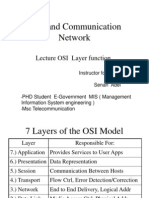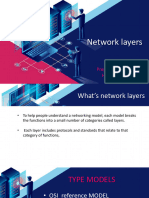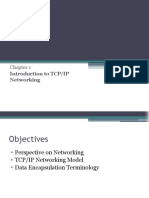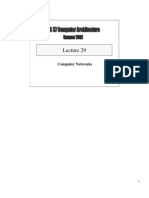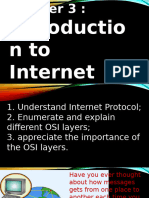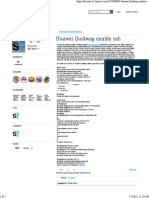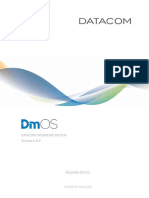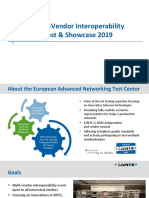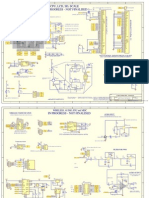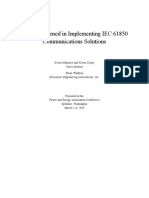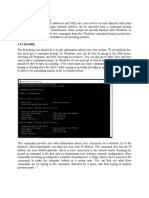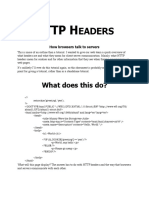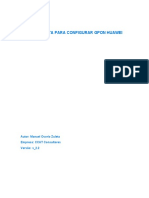0 ratings0% found this document useful (0 votes)
93 viewsNetwork Standards: Prepared By: Devang K. Bhatti
Network Standards: Prepared By: Devang K. Bhatti
Uploaded by
devangbhattiThe document discusses the OSI reference model, which consists of 7 layers designed to standardize network communication. It describes each layer's responsibilities, with Layer 1 dealing with physical communication and Layer 7 dealing with application-level processes. Examples are provided to illustrate key points about addressing schemes, protocols, and standards bodies like ISO and IEEE that helped develop layered network models.
Copyright:
Attribution Non-Commercial (BY-NC)
Available Formats
Download as PPT, PDF, TXT or read online from Scribd
Network Standards: Prepared By: Devang K. Bhatti
Network Standards: Prepared By: Devang K. Bhatti
Uploaded by
devangbhatti0 ratings0% found this document useful (0 votes)
93 views22 pagesThe document discusses the OSI reference model, which consists of 7 layers designed to standardize network communication. It describes each layer's responsibilities, with Layer 1 dealing with physical communication and Layer 7 dealing with application-level processes. Examples are provided to illustrate key points about addressing schemes, protocols, and standards bodies like ISO and IEEE that helped develop layered network models.
Original Description:
Developed by Devang K Bhatti
Original Title
OSI
Copyright
© Attribution Non-Commercial (BY-NC)
Available Formats
PPT, PDF, TXT or read online from Scribd
Share this document
Did you find this document useful?
Is this content inappropriate?
The document discusses the OSI reference model, which consists of 7 layers designed to standardize network communication. It describes each layer's responsibilities, with Layer 1 dealing with physical communication and Layer 7 dealing with application-level processes. Examples are provided to illustrate key points about addressing schemes, protocols, and standards bodies like ISO and IEEE that helped develop layered network models.
Copyright:
Attribution Non-Commercial (BY-NC)
Available Formats
Download as PPT, PDF, TXT or read online from Scribd
Download as ppt, pdf, or txt
0 ratings0% found this document useful (0 votes)
93 views22 pagesNetwork Standards: Prepared By: Devang K. Bhatti
Network Standards: Prepared By: Devang K. Bhatti
Uploaded by
devangbhattiThe document discusses the OSI reference model, which consists of 7 layers designed to standardize network communication. It describes each layer's responsibilities, with Layer 1 dealing with physical communication and Layer 7 dealing with application-level processes. Examples are provided to illustrate key points about addressing schemes, protocols, and standards bodies like ISO and IEEE that helped develop layered network models.
Copyright:
Attribution Non-Commercial (BY-NC)
Available Formats
Download as PPT, PDF, TXT or read online from Scribd
Download as ppt, pdf, or txt
You are on page 1of 22
Network Standards
OSI Reference Model
Prepared By: Devang K. Bhatti
History
• Rapid growth of computer networks caused
compatibility problems
• ISO (International Organization for
Standardization) recognized the problem and
released the OSI model in 1984
• OSI stands for Open Systems Interconnection and
consists of 7 Layers
• The use of layers is designed to reduce complexity
and make standardization easier
Prepared By: Devang K. Bhatti
7 Layers of the OSI Model
Layer Responsible For:
7.) Application Provides Services to User Apps
6.) Presentation Data Representation
5.) Session Communication Between Hosts
4.) Transport Flow Ctrl, Error Detection/Correction
3.) Network End to End Delivery, Logical Addr
2.) Data Link Media Access Ctrl, Physical Addr
1.) Physical Medium, Interfaces, Puts Bits on Med.
Prepared By: Devang K. Bhatti
Examples
Layer Example
7.) Application HTTP, FTP, SMTP
6.) Presentation ASCII, JPEG, PGP
5.) Session BOOTP, NetBIOS, DHCP, DNS
4.) Transport TCP, UDP, SPX
3.) Network IP, IPX, ICMP
2.) Data Link Ethernet, Token Ring, Frame Relay
1.) Physical Bits, Interfaces, Hubs
Prepared By: Devang K. Bhatti
Mnemonics
(A)ll 7.) (A)pplication (A)way
(P)eople 6.) (P)resentation (P)izza
(S)eem 5.) (S)ession (S)ausage
(T)o 4.) (T)ransport (T)hrow
(N)eed 3.) (N)etwork (N)ot
(D)ata 2.) (D)ata Link (D)o
(P)rocessing 1.) (P)hysical (P)lease
Prepared By: Devang K. Bhatti
Flat Addressing
• Flat addressing schemes do not provide
anything other than a unique identifier.
They provide no real information about
where the object being addressed resides.
• Example: Birth Certificate (may provide
insight to where the person was born, but
not to where they are now)
Prepared By: Devang K. Bhatti
Hierarchical Addressing
• Hierarchical addressing schemes provide
layers or a hierarchy to the address that
provide information about where the
addressed object exists within the hierarchy.
• Example: phone numbers (area code, local
prefix, and four digit number unique to that
area code/prefix combination).
Prepared By: Devang K. Bhatti
Talking to Everyone
• Special kinds of addresses exist at both
layer #2 and #3 called broadcast addresses
• Typically network devices are interested in
only traffic addressed directly for them and
any traffic addressed with the destination
address set to broadcast
• If they are paying attention to other traffic,
they are said to be in promiscuous mode
Prepared By: Devang K. Bhatti
Layer 1: The Physical Layer
• Defines physical medium and interfaces
• Determines how bits are represented
• Controls transmission rate & bit
synchronization
• Controls transmission mode: simplex, half-
duplex, & full duplex
• Devices: hubs, cables, connectors, etc…
Prepared By: Devang K. Bhatti
Layer 2: The Data Link Layer
• Keeps Link alive & provides connection for
upper layer protocols
• Based on physical (flat) address space
• Physical addresses are fixed and don’t
change when the node is moved
• Medium/media access control
Prepared By: Devang K. Bhatti
The Data Link Layer (cont.)
• Flow control and error detection/correction
at the frame level. Think collisions…
• Topology
• Ex: Ethernet, Token Ring, ISDN
• Sublayers: MAC (framing, addressing, &
MAC) & LLC (logical link control – gives
error control & flow control)
• Devices: switches, bridges, NIC’s
Prepared By: Devang K. Bhatti
Layer 3: The Network Layer
• End to end delivery of packets
• Creates logical paths
• Path determination (routing)
• Hides the lower layers making things
hardware independent
• Uses logical hierarchical addresses
Prepared By: Devang K. Bhatti
The Network Layer (cont.)
• Logical hierarchical addresses do change
when a node is moved to a new subnet
• Devices: routers, firewalls
Prepared By: Devang K. Bhatti
Layer 4: The Transport Layer
• Service Point Address (more often called a
port) used to track multiple sessions
between the same systems. SPA’s are used
to allow a node to offer more than one
service (i.e. it could offer both mail and
web services)
• This layer is why you have to specify TCP
or UDP when dealing with TCP/IP
Prepared By: Devang K. Bhatti
The Transport Layer (cont.)
• Must reassemble segments into data using
sequence numbers
• Can use either connectionless or connection
oriented sessions
• Connectionless sessions rely on upper layer
protocols for error control and are often used for
faster less reliable links
• Ex: UDP (used by things like NFS & DNS)
Prepared By: Devang K. Bhatti
The Transport Layer (cont.)
• Connection oriented sessions require the sender to
first request a connection, the receiver to
acknowledge the connection, and that they
negotiate how much data can be sent/received
before its reception is acknowledged
• Uses acknowledgements & retransmission for
error correction
• Example: TCP (used by things like telnet, http)
Prepared By: Devang K. Bhatti
Layer 5: The Session Layer
• Sometimes called the dialog controller, this
layer establishes, maintains, and terminates
sessions between applications
• Defines checkpoints for acknowledgements
during sessions between applications
Prepared By: Devang K. Bhatti
The Session Layer (cont.)
• Provides atomization – Multiple connections can
be treated as one virtual session. If one fails or is
terminated, all should be terminated.
• Identifies raw data as either application data or
session control information
• Uses fields provided by layers 3 & 4 to track
dialogs between applications / services
• Provides translations for naming services
Prepared By: Devang K. Bhatti
Layer 6: The Presentation Layer
• Data formatting, translation, encryption,
and compression
• Ex: ASCII, EBCDIC, HTML, JPEG
Prepared By: Devang K. Bhatti
Layer 7: The Application Layer
• Provides communication services to
applications
• Ex: HTTP, FTP, SMTP
Prepared By: Devang K. Bhatti
IEEE Standards
• IEEE project 802 started in 1985
• Adopted by ANSI in 1987
• Recognized as an international standard by
the ISO as ISO 8802
• Deals with layers 1 & 2
Prepared By: Devang K. Bhatti
IEEE Standards (cont.)
• At the data link layer (layer 2), defines
MAC and LLC sublayers
• LLC covers media independent topics
(802.2 is the LLC standard)
• MAC topics are dependent on media
(802.3, 802.11, 802.5)
• At the physical layer (layer 1), defines a
PMI and PMD
Prepared By: Devang K. Bhatti
You might also like
- VSOL Special FeaturesDocument55 pagesVSOL Special FeaturesEnzo GodoyNo ratings yet
- Subnet Mask Cheat SheetDocument4 pagesSubnet Mask Cheat SheetdP gamingNo ratings yet
- Lec-3 Layer OSI ModelDocument34 pagesLec-3 Layer OSI ModelDivya GuptaNo ratings yet
- 7 Layer OSI Model Open System Interconnection ModelDocument44 pages7 Layer OSI Model Open System Interconnection ModelÑätÎnk EtNo ratings yet
- Data and Communication Network: Lecture OSI Layer FunctionDocument19 pagesData and Communication Network: Lecture OSI Layer FunctionSenan AlkaabyNo ratings yet
- Osi LayersDocument58 pagesOsi LayersThe UnCONFUSEDNo ratings yet
- Protocol Reference Model of OSIDocument28 pagesProtocol Reference Model of OSIemmanuel AumsuriNo ratings yet
- Models - An OverviewDocument129 pagesModels - An OverviewAlfred MasekwamengNo ratings yet
- Lec 4Document15 pagesLec 4ippili24181No ratings yet
- OSI Model: MIS 416 - Module II Spring 2002Document17 pagesOSI Model: MIS 416 - Module II Spring 2002mamtaNo ratings yet
- 01 Hanif OSI Model and TCP IP ModelDocument32 pages01 Hanif OSI Model and TCP IP ModelKāshān AsimNo ratings yet
- OSI ModelDocument17 pagesOSI ModelHarjot SinghNo ratings yet
- OSI Model: Mrs. J. DevasundarrajDocument17 pagesOSI Model: Mrs. J. DevasundarrajdevasundarNo ratings yet
- Network ModelsDocument42 pagesNetwork Modelssakshipowar144No ratings yet
- OSI Model: Spring 2022 Data Communication ITM 315Document17 pagesOSI Model: Spring 2022 Data Communication ITM 315Fahmida Nur RiaNo ratings yet
- OSI Model: MIS 416 - Module II Spring 2002 Networking and Computer SecurityDocument17 pagesOSI Model: MIS 416 - Module II Spring 2002 Networking and Computer Securitydyake04No ratings yet
- OSI ModelDocument11 pagesOSI ModelMkt RayNo ratings yet
- Computer Network Chapter 4Document45 pagesComputer Network Chapter 4mawdodi.sadamNo ratings yet
- IP Basics and Routing Protocols PDFDocument241 pagesIP Basics and Routing Protocols PDFWubie NegaNo ratings yet
- OsiDocument11 pagesOsiyepayik229No ratings yet
- 1.Network ProtocolsDocument7 pages1.Network Protocolshsuhhehe528No ratings yet
- OSI ModelDocument31 pagesOSI Modelmissiongaire132No ratings yet
- Introduction To 7 Layer OSI ModelDocument35 pagesIntroduction To 7 Layer OSI ModelMin Kwon100% (1)
- TCPIPDocument10 pagesTCPIPAmmar KhaggahNo ratings yet
- OSI Model 1Document17 pagesOSI Model 1RodrigoNo ratings yet
- Defining Networks With The OSI ModelDocument29 pagesDefining Networks With The OSI ModelPradeep ManralNo ratings yet
- Network Layers Lecture 1Document23 pagesNetwork Layers Lecture 1syabo.00315660No ratings yet
- 5 Internet ProtocolsDocument41 pages5 Internet Protocolsstephenhilario3434No ratings yet
- Lesson 4 - OSI ModelDocument15 pagesLesson 4 - OSI Modelemanuelokala5No ratings yet
- Computer Systems Servicing: Quarter 3Document10 pagesComputer Systems Servicing: Quarter 3Jeffrey MacabareNo ratings yet
- Network Reference Model - ENAMDocument56 pagesNetwork Reference Model - ENAMturiagabaNo ratings yet
- 01 CCNA 200-301 Chapter 1-Introduction To TCP IP NetworkingDocument21 pages01 CCNA 200-301 Chapter 1-Introduction To TCP IP NetworkingJuan Pablo AragonNo ratings yet
- Unit 1 OsitcpDocument28 pagesUnit 1 OsitcpsudhamshavejendlaNo ratings yet
- Introduction To TCP IP NetworkingDocument21 pagesIntroduction To TCP IP NetworkingsugapriyaNo ratings yet
- Network Tools and Techniques: Dr.P.Mohana Priya Ap - I, Department of IT, School of Computing, SASTRA Deemed UniversityDocument77 pagesNetwork Tools and Techniques: Dr.P.Mohana Priya Ap - I, Department of IT, School of Computing, SASTRA Deemed UniversityjayshreeNo ratings yet
- Protocols Invovled in TcipDocument23 pagesProtocols Invovled in TcipFiremandeheavenly InamenNo ratings yet
- Network Protocol and TCPDocument5 pagesNetwork Protocol and TCPJoshua SantillanaNo ratings yet
- 2.2-3 OSI LayersDocument12 pages2.2-3 OSI LayersGerald E BaculnaNo ratings yet
- OSI Reference Model and TCPDocument6 pagesOSI Reference Model and TCPKommireddy Siva Kumar100% (1)
- Computer Science 37 Lecture 29Document18 pagesComputer Science 37 Lecture 29Alexander TaylorNo ratings yet
- CCNANOTESDocument86 pagesCCNANOTESSunkadahalli Govindaiah Bhanu PrakashNo ratings yet
- TCP IP LayerDocument31 pagesTCP IP LayerVenu KarunanithiNo ratings yet
- Networking Made EasyDocument46 pagesNetworking Made EasySelene Khan JadoonNo ratings yet
- Aspectos Fundamentales de Redes-02Document29 pagesAspectos Fundamentales de Redes-02Sara Esther Domínguez MirandaNo ratings yet
- 5_INTERNET_PROTOCOLSDocument41 pages5_INTERNET_PROTOCOLSRichard Reyes Jr.No ratings yet
- Computer Networks_(OSI and TCP Model) (1)Document69 pagesComputer Networks_(OSI and TCP Model) (1)Ghaffar BuzdarNo ratings yet
- Lecture-7 OSI ModelDocument34 pagesLecture-7 OSI Modelhastings770126No ratings yet
- A Brief Summary On TCP/IPDocument30 pagesA Brief Summary On TCP/IPShubham VishwakarmaNo ratings yet
- CCNADocument15 pagesCCNAdeepikasubramani000No ratings yet
- CN1Document39 pagesCN1abhyaNo ratings yet
- Computer Network Workshop 2022 - DADocument63 pagesComputer Network Workshop 2022 - DAkirolosmagdyNo ratings yet
- Computer Network FundmentalsDocument75 pagesComputer Network Fundmentalsdba.mostafa.hassanNo ratings yet
- Chapter 2 - Network BasicsDocument64 pagesChapter 2 - Network Basicspalesamohalla31No ratings yet
- Week2-Application Layer FixDocument38 pagesWeek2-Application Layer FixBaekhyuneeNo ratings yet
- Applc TRNSPT NW LAyersDocument29 pagesApplc TRNSPT NW LAyersa NaniNo ratings yet
- Osi Model CompleteDocument4 pagesOsi Model Completebaraynavab100% (9)
- Ccna Icnd1 Study NotesDocument187 pagesCcna Icnd1 Study NotesRohitSinghNo ratings yet
- CNDocument8 pagesCNrajghag0409No ratings yet
- TCP-IP and OSIDocument22 pagesTCP-IP and OSIADE SATRIOWIRAWANNo ratings yet
- Module1 Layered Architecture Chap2Document79 pagesModule1 Layered Architecture Chap2Karthik YogeshNo ratings yet
- Cisco Certified Network Associate (CCNA) and Cisco Certified Network Professional (CCNP): Mastering Network Automation and Programmability Study GuideFrom EverandCisco Certified Network Associate (CCNA) and Cisco Certified Network Professional (CCNP): Mastering Network Automation and Programmability Study GuideNo ratings yet
- 1 Define: Directory Services: UNIT-1Document18 pages1 Define: Directory Services: UNIT-1Akanksha BhagatNo ratings yet
- SIP Server Acme SBC Application NoteDocument17 pagesSIP Server Acme SBC Application NoteCarlos J G GonzalezNo ratings yet
- Huawei Enable SSHDocument2 pagesHuawei Enable SSHRolando FigueroaNo ratings yet
- 204.4295.45 - DmOS - Release Notes - 6.0.0 - EnglishDocument27 pages204.4295.45 - DmOS - Release Notes - 6.0.0 - Englishj7tNo ratings yet
- Ospf MultiDocument4 pagesOspf MultiVianey LopezNo ratings yet
- MPLSSDNNFV Eantc Guided Tours 3Document34 pagesMPLSSDNNFV Eantc Guided Tours 3TuPro FessionalNo ratings yet
- Mid Term Report On SS7Document17 pagesMid Term Report On SS7Shivam ChhabraNo ratings yet
- The Big Book of CCNA StudyDocument381 pagesThe Big Book of CCNA StudyAlain Bogne0% (1)
- h15300 Vxrail Network GuideDocument29 pagesh15300 Vxrail Network GuideJose L. RodriguezNo ratings yet
- Hws 13642Document3 pagesHws 13642dhieward100% (2)
- Lessons Learned in Implementing IEC 61850 Communications SolutionsDocument13 pagesLessons Learned in Implementing IEC 61850 Communications SolutionsVamsi ManojNo ratings yet
- Access Switching - CursoDocument723 pagesAccess Switching - CursoAlberto Isturiz100% (1)
- Topic 1Document34 pagesTopic 1mohamedNo ratings yet
- 1.4 Basic Network UtilitiesDocument4 pages1.4 Basic Network UtilitiesmeeeNo ratings yet
- Security zOSDocument360 pagesSecurity zOSvgrynyukNo ratings yet
- Fire WalkingDocument18 pagesFire Walkingg4ubhNo ratings yet
- SAPROUTER Configuration For LANCO11239501081Document6 pagesSAPROUTER Configuration For LANCO11239501081Raymond YambaoNo ratings yet
- Sec User Services 15 1 BookDocument1,291 pagesSec User Services 15 1 BookEnis ByciNo ratings yet
- Chapter 5 Virtual LAN (VLAN)Document62 pagesChapter 5 Virtual LAN (VLAN)nuhonoNo ratings yet
- R6511 BDocument45 pagesR6511 BPithoon UngnaparatNo ratings yet
- JHA Industrial SwitchDocument4 pagesJHA Industrial SwitchcuongarsNo ratings yet
- Briskinfosec Pentest ToolkitDocument17 pagesBriskinfosec Pentest ToolkitBriskinfosec Technology and Consulting Pvt LtdNo ratings yet
- Data Link Layer and Media AccessDocument22 pagesData Link Layer and Media AccessE.VigneshNo ratings yet
- 0752 HTTP Headers PDFDocument6 pages0752 HTTP Headers PDFHidayat HijaziNo ratings yet
- 16-2 p30 Mapping of j1939 To Can FD Cia602 ZeltwangerDocument2 pages16-2 p30 Mapping of j1939 To Can FD Cia602 ZeltwangerAlireza RakhshNo ratings yet
- CCTV DBRDocument40 pagesCCTV DBRsupertechenterprise7No ratings yet
- Eigrp SummaryDocument8 pagesEigrp SummaryCCNAResourcesNo ratings yet
- Ferramentas GPON Huawei - CCATDocument144 pagesFerramentas GPON Huawei - CCATSebastian MontesNo ratings yet





